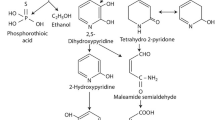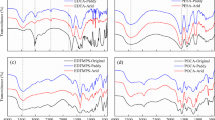Abstract
The effectiveness of many bioremediation systems for PAH-contaminated soil may be constrained by low contaminant bioaccessibility due to limited aqueous solubility or large sorption capacity. Information on the extent to which PAHs can be readily biodegraded is of vital importance in the decision whether or not to remediate a contaminated soil. In the present study the rate-limiting factors in methyl-β-cyclodextrin (MCD)-enhanced bioremediation of PAH-contaminated soil were evaluated. MCD amendment at 10 % (w/w) combined with inoculation with the PAH-degrading bacterium Paracoccus sp. strain HPD-2 produced maximum removal of total PAHs of up to 35 %. The desorption of PAHs from contaminated soil was determined before and after 32 weeks of bioremediation. 10 % (w/w) MCD amendment (M2) increased the Tenax extraction of total PAHs from 12 to 30 % and promoted degradation by up to 26 % compared to 6 % in the control. However, the percentage of Tenax extraction for total PAHs was much larger than that of degradation. Thus, in the control and M2 treatment it is likely that during the initial phase the bioaccessibility of PAHs is high and biodegradation rates may be limited by microbial processes. On the other hand, when the soil was inoculated with the PAH-degrading bacterium (CKB and MB2), the slowly and very slowly desorbing fractions (F sl and F vl ) became larger and the rate constants of slow and very slow desorption (k sl and k vl ) became extremely small after bioremediation, suggesting that desorption is likely rate limiting during the second, slow phase of biotransformation. These results have practical implications for site risk assessment and cleanup strategies.




Similar content being viewed by others
References
Allan IJ, Semple KT, Hare R, Reid BJ (2007) Cyclodextrin enhanced biodegradation of polycyclic aromatic hydrocarbons and phenols in contaminated soil slurries. Environ Sci Technol 41:5498–5504
Allan IJ, Ruus A, Schaanning MT, Macrae KJ, Naes K (2012) Measuring nonpolar organic contaminant partitioning in three Norwegian sediments using polyethylene passive samplers. Sci Total Environ 423:125–131
Alonso-Gutiérrez J, Figueras A, Albaigés J, Jiménez N, Viñas M, Solanas AM, Novoa B (2009) Bacterial communities from shoreline environments (Costa da Morte, Northwestern Spain) affected by the Prestige oil spill. Appl Environ Microbiol 75:3407–3418
Baczynski TP, Pleissner D, Krylow M (2012) Bioremediation of chlorinated pesticides in field-contaminated soils and suitability of Tenax solid-phase extraction as a predictor of its effectiveness. Clean Soil Air Water. doi:10.1002/clen.201100024
Bardi L, Martini C, Opsi F, Bertolone E, Belviso S, Masoero G, Marzona M, Marsan FA (2007) Cyclodextrin enhanced in situ bioremediation of polyaromatic hydrocarbons contaminated soils and plant uptake. J Incl Phenom Macro 57:439–444
Chen JL, Wong MH, Wong YS, Tam NFY (2008) Multi-factors on biodegradation kinetics of polycyclic aromatic hydrocarbons (PAHs) by Sphingomonas sp., a bacterial strain isolated from mangrove sediment. Mar Pollut Bull 57:695–702
Cornelissen G, Henk R, Hulscher DEM, Vrind BA, Noort PCM (2001) A simple Tenax® extraction method to determine the availability of sediment-sorbed organic compounds. Environ Toxicol Chem 20:706–711
Denef VJ, Kalnejais LH, Mueller RS, Wilmes P, Baker BJ, Thomas BC, Verberkmoes NC, Hettich RL, Banfield JF (2010) Proteogenomic basis for ecological divergence of closely related bacteria in natural acidophilic microbial communities. PNAS 107:2383–2390
Gouliarmou V, Smith KEC, Jonge LW, Mayer P (2012) Measuring binding and speciation of hydrophobic organic chemicals at controlled freely dissolved concentrations and without phase separation. Anal Chem 84:1601–1608
Guo CL, Dang Z, Wong Y, Tam NF (2010) Biodegradation ability and dioxygenase genes of PAH-degrading Sphingomonas and Mycobacterium strains isolated from mangrove sediments. Int Biodeter Biodegr 64:419–426
Hamdi H, Benzarti S, Manusadžianas L, Aoyama I, Jedidi N (2007) Bioaugmentation and biostimulation effects on PAH dissipation and soil ecotoxicity under controlled conditions. Soil Biol Biochem 39:1926–1935
Harmsen J (2007) Measuring bioavailability: from a scientific approach to standard methods. J Environ Qual 36:1420–1428
Kah M, Beulke S, Brown CD (2007) Factors influencing degradation of pesticides in soil. J Agric Food Chem 55:4487–4492
Li CH, Wong YS, Tam NFY (2010) Anaerobic biodegradation of polycyclic aromatic hydrocarbons with amendment of iron(III) in mangrove sediment slurry. Bioresour Technol 101:8083–8092
Liu M, Tian SY, Chen P, Zhu LY (2011) Predicting the bioavailability of sediment-associated polybrominated diphenyl ethers using a 45-d sequential Tenax extraction. Chemosphere 85:424–431
Mahanty B, Pakshirajan K, Venkata Dasu V (2007) Biodegradation of pyrene by Mycobacterium frederiksbergense in a two-phase partitioning bioreactor system. Bioresour Technol 99:2694–2698
Mayer P, Olsen JL, Gouliarmou V, Hasinger M, Kendler R, Loibner AP (2011) A contaminant trap as a tool for isolating and measuring the desorption resistant fraction of soil pollutants. Environ Sci Technol 45:2932–2937
Megharaj M, Ramakrishnana B, Venkateswarlua K, Sethunathand N, Naidu R (2011) Bioremediation approaches for organic pollutants: a critical perspective. Environ Int 37:1362–1375
Montes MB, Springael D, Calvo JJO (2011) Effect of a nonionic surfactant on biodegradation of slowly desorbing PAHs in contaminated soils. Environ Sci Technol 45:3019–3026
Ni JZ, Luo YM, Wei R, Li XH (2008) Distribution patterns of polycyclic aromatic hydrocarbons among different organic carbon fractions of polluted agricultural soils. Geoderma 146(1–2):277–282
Oleszczuk P (2009) Application of the three methods used for the evaluation of polycyclic aromatic hydrocarbons (PAHs) bioaccessibility for sewage sludge composting. Bioresour Technol 100:413–420
Petitgirard A, Djehiche M, Persello J, Fievet P, FatinRouge N (2009) PAH contaminated soil remediation by reusing an aqueous solution of cyclodextrins. Chemosphere 75:714–718
Reichenberg F, Karlson UG, Gustafsson O, Long SM, Pritchard PH, Mayer P (2010) Low accessibility and chemical activity of PAHs restrict bioremediation and risk of exposure in a manufactured gas plant soil. Environ Pollut 158:1214–1220
Rhodes AR, McAllister LE, Semple KT (2010) Linking desorption kinetics to phenanthrene biodegradation in soil. Environ Pollut 158:1348–1353
Richardson SD, Aitken MD (2011) Desorption and bioavailability of polycyclic aromatic hydrocarbons in contaminated soil subjected to long-term in situ biostimulation. Environ Toxicol Chem 30:2674–2681
Schwab K, Brack W (2007) Large volume Tenax extraction of the bioaccessible fraction of sediment-associated organic compounds for a subsequent effect-directed analysis. J Soils Sediments 3:178–186
Semple KT, Doick KJ, Doick LY, Harms H (2007) Microbial interactions with organic contaminants in soil: definitions, processes and measurement. Environ Pollut 150:166–176
Song Y, Wang F, Yang XL, Liu CY, Fredrick OK, Jin X, Jiang X (2011) Chemical extraction to assess the bioavailability of chlorobenzenes in soil with different aging periods. J Soils Sediments 11:1345–1354
Sun MM, Fu DQ, Teng Y, Shen YY, Luo YM, Li ZG, Christie P (2011) In situ phytoremediation of PAH-contaminated soil by intercropping alfalfa (Medicago sativa L.) with tall fesc (Festuca arundinacea Schreb.) and associated soil microbial activity. J Soils Sediments 11:980–989
Teng Y, Luo YM, Sun MM, Liu Z, Li ZG, Christie P (2010a) Effects of soil amendment with different carbon sources and other factors on the bioremediation of an aged PAH-contaminated soil. Biodegradation 21:167–178
Teng Y, Luo YM, Sun MM, Liu ZJ, Li ZG, Christie P (2010b) Effect of bioaugmentation by Paracoccus sp. strain HPD-2 on the soil microbial community and removal of polycyclic aromatic hydrocarbons from an aged contaminated soil. Bioresour Technol 101:3437–3443
Trimble TA, You J, Lydy M (2007) Bioavailability of PCBs from field-collected sediments: application of Tenax extraction and matrix-SPEM techniques. Chemosphere 71:337–344
Yang XL, Wang F, Gu CG, Jiang X (2010) Tenax TA extraction to assess the bioavailability of DDTs in cotton field soils. J Hazard Mater 179:676–683
Yang Y, Zhang N, Xue M, Lu ST, Tao S (2011) Effects of soil organic matter on the development of the microbial polycyclic aromatic hydrocarbons (PAHs) degradation potentials. Environ Pollut 159:591–595
Acknowledgments
This work was supported by Grants from the Natural Science Foundation of Jiangsu Province (Project BK2009016), the Chinese National Environmental Protection Special Funds for Scientific Research on Public Causes (Project 2010467016), and the Chinese National High Technology Research and Development Program (863 Program) (Project 2007AA061101).
Author information
Authors and Affiliations
Corresponding author
Rights and permissions
About this article
Cite this article
Sun, M., Luo, Y., Teng, Y. et al. Tenax TA extraction to understand the rate-limiting factors in methyl-β-cyclodextrin-enhanced bioremediation of PAH-contaminated soil. Biodegradation 24, 365–375 (2013). https://doi.org/10.1007/s10532-012-9593-2
Received:
Accepted:
Published:
Issue Date:
DOI: https://doi.org/10.1007/s10532-012-9593-2




